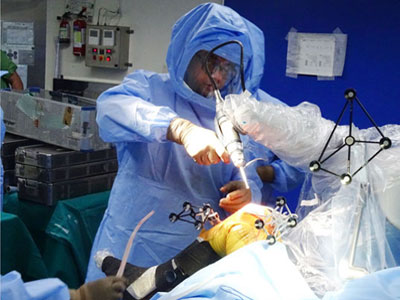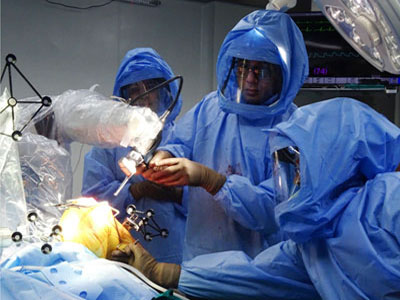Robotic Assisted Partial Knee Replacement Surgery
In the realm of orthopedic surgery, advancements in technology have paved the way for more precise and effective procedures, notably in the form of Robotic Assisted Partial Knee Replacement Surgery. This innovative approach combines the expertise of skilled surgeons with cutting-edge robotic systems, enhancing the precision and accuracy of partial knee replacements. This comprehensive guide aims to shed light on the intricacies of this procedure, from its definition to the recovery process.
What is Robotic Partial Knee Surgery?
Robotic Partial Knee Surgery, also known as Robotic Assisted Partial Knee Replacement, is a state-of-the-art procedure designed to address specific areas of the knee affected by osteoarthritis or injury. Unlike total knee replacements, which involve replacing the entire knee joint, this surgery focuses on selectively replacing damaged portions while preserving healthy bone and tissue. This targeted approach allows for a more natural knee motion and potentially quicker recovery.
How do Robotic Partial Knee Replacements Work?
At the core of Robotic Partial Knee Replacements lies advanced technology, such as the Mako Robotic Arm-Assisted System. This system assists surgeons in mapping the knee's anatomy through preoperative CT scans. During surgery, the robotic arm aids the surgeon in precise bone preparation and implant placement, ensuring optimal alignment and fit. This level of accuracy contributes to better outcomes and patient satisfaction.

Who is a Candidate for Robotic Partial Knee Replacement?
Candidates for Robotic Partial Knee Replacement typically exhibit localized knee arthritis or damage confined to specific compartments of the knee joint. Individuals experiencing persistent knee pain, swelling, stiffness, and limited mobility despite conservative treatments like medication or physical therapy might be suitable candidates. A thorough evaluation by a qualified orthopedic surgeon is essential to determine candidacy.
Robotic Assisted Partial Knee Surgery Procedure
The procedure begins with detailed imaging of the patient's knee using CT scans, allowing the surgeon to create a personalized surgical plan. During the operation, the surgeon utilizes the robotic arm to execute the pre-defined plan with utmost precision. Through smaller incisions compared to traditional surgery, damaged tissue is replaced with artificial implants, tailored to fit the patient's unique anatomy.
What are the Advantages of Robotic Partial Knee Replacement Surgery?
- Precision and Accuracy: The robotic system assists surgeons in achieving precise bone cuts and implant placement, potentially leading to better outcomes.
- Conservation of Healthy Tissue: By targeting only the damaged area, healthy bone and tissue preservation is prioritized, aiding in natural knee function.
- Faster Recovery: Some patients experience quicker rehabilitation and shorter hospital stays due to the minimally invasive nature of the procedure.
- Enhanced Long-Term Results: Improved alignment and fit of the implant may contribute to long-term success and patient satisfaction.
Robotic Partial Knee Replacement Recovery Process
Following surgery, a comprehensive rehabilitation program is tailored to each patient to promote healing and regain mobility. Physical therapy plays a pivotal role in strengthening muscles, restoring joint function, and optimizing recovery. While recovery timelines may vary, many patients experience reduced pain and improved knee function within weeks, gradually returning to their daily activities.
In conclusion, Robotic Assisted Partial Knee Replacement Surgery stands as a milestone in orthopedic care, offering precise, personalized solutions for individuals suffering from localized knee issues. With the fusion of advanced robotics and skilled surgical expertise, this procedure holds promise in providing patients with renewed hope for improved knee function and an enhanced quality of life.
For individuals considering Robotic Partial Knee Replacement Surgery, consulting experienced robotic partial knee replacement surgeons who specialize in robotic joint replacement procedures is crucial. Embracing the benefits of Mako robotics for partial knee replacements marks a significant step towards a more efficient and effective joint care approach.







Frequently Asked Questions about Robotic Partial Knee Replacement
Q: Why would I choose robotic partial knee replacement over robotic total knee replacement?
A: Robotic partial knee replacement is chosen when only a portion of the knee joint is affected by arthritis or damage. It preserves healthy tissue and bone, offering a more conservative option compared to total knee replacement. This can lead to quicker recovery, less postoperative pain, and a more natural feeling in the knee.
Q: What are the results of robotic partial knee replacement?
A: Robotic partial knee replacement has shown positive outcomes in terms of improved knee function, reduced pain, and quicker rehabilitation compared to traditional surgeries. Patients often experience faster recovery times and a more natural range of motion in the affected knee.
Q: Why does the Mako system work well for partial knee replacement?
A: The Mako system utilizes advanced technology, such as 3D imaging and precision mapping, allowing for accurate and personalized surgical plans. This system enables surgeons to specifically target only the damaged portion of the knee, sparing healthy tissue and ligaments. The precise nature of the Mako system contributes to better alignment, fit, and overall success in partial knee replacements.


